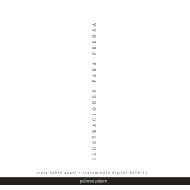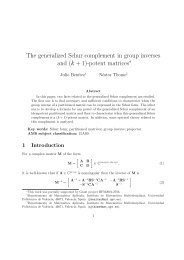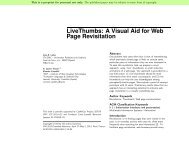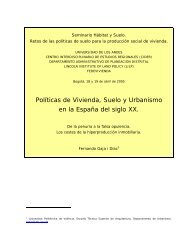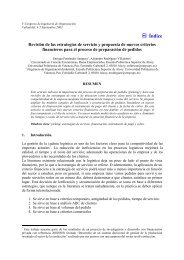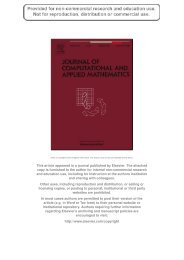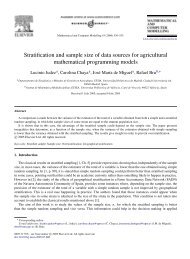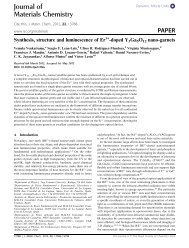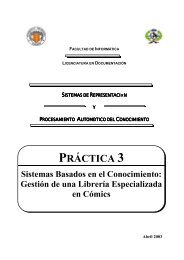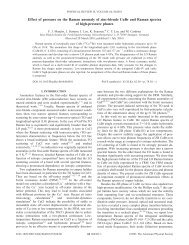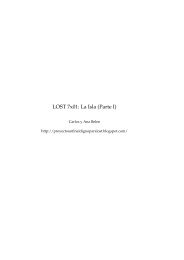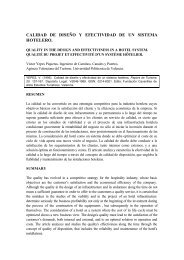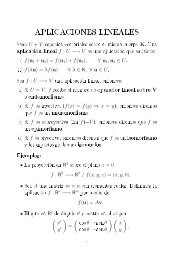Introduction to the resistivity surveying method. The resistivity of ...
Introduction to the resistivity surveying method. The resistivity of ...
Introduction to the resistivity surveying method. The resistivity of ...
You also want an ePaper? Increase the reach of your titles
YUMPU automatically turns print PDFs into web optimized ePapers that Google loves.
27<br />
2.7.4 Landslide - Cangkat Jering, Malaysia<br />
A recent problem faced in Malaysia is landslides on hill slopes. <strong>The</strong> landslides are<br />
<strong>of</strong>ten triggered by water accumulation within part <strong>of</strong> <strong>the</strong> slope which leads <strong>to</strong> weakening <strong>of</strong> a<br />
section <strong>of</strong> <strong>the</strong> slope. Figure 19 shows <strong>the</strong> results from a survey conducted on <strong>the</strong> upper part <strong>of</strong><br />
a slope where a landslide had occurred in <strong>the</strong> lower section. Wea<strong>the</strong>ring <strong>of</strong> <strong>the</strong> granitic<br />
bedrock produced a clayey sandy soil mixed with core boulders and o<strong>the</strong>r partially wea<strong>the</strong>red<br />
material. <strong>The</strong> image obtained from this survey shows a prominent low <strong>resistivity</strong> zone below<br />
<strong>the</strong> centre <strong>of</strong> <strong>the</strong> survey line. This is probably caused by water accumulation in this region<br />
which reduces <strong>the</strong> <strong>resistivity</strong> <strong>to</strong> less than 600 Ohm•m. To stabilise <strong>the</strong> slope, it would be<br />
necessary <strong>to</strong> pump <strong>the</strong> excess water from this zone. Thus, it is important <strong>to</strong> accurately map <strong>the</strong><br />
zone <strong>of</strong> ground water accumulation. This data set also shows an example with <strong>to</strong>pography in<br />
<strong>the</strong> model section.<br />
2.7.5 Old Tar Works - U.K.<br />
A common environmental problem in industrial countries is derelict industrial land.<br />
Before such land can be rehabilitated, it is necessary <strong>to</strong> map old industrial materials (such as<br />
metals and concrete blocks) that are left buried in <strong>the</strong> ground. Ano<strong>the</strong>r problem in such areas<br />
is chemical wastes that had been s<strong>to</strong>red within <strong>the</strong> fac<strong>to</strong>ry grounds. Due <strong>to</strong> <strong>the</strong> nature <strong>of</strong> such<br />
sites, <strong>the</strong> subsurface is <strong>of</strong>ten very complex and is a challenging target for most geophysical<br />
<strong>method</strong>s. <strong>The</strong> survey for this example was carried out on a derelict industrial site where<br />
leachate was known, from a small number <strong>of</strong> explora<strong>to</strong>ry wells, <strong>to</strong> be moving from a surface<br />
waste lagoon in<strong>to</strong> <strong>the</strong> underlying sands<strong>to</strong>nes (Barker 1996). Eventually <strong>the</strong> leachate was seen<br />
seeping in<strong>to</strong> a nearby stream. However, <strong>the</strong> extent <strong>of</strong> <strong>the</strong> subsurface contamination was not<br />
known.<br />
An electrical imaging survey was carried out along an old railway bed between <strong>the</strong><br />
lagoon and <strong>the</strong> stream. <strong>The</strong> metal railway lines had been removed except for short lengths<br />
embedded in asphalt below a large metal loading bay. In <strong>the</strong> apparent <strong>resistivity</strong><br />
pseudosection (Figure 20a), <strong>the</strong> area with contaminated ground water shows up as a low<br />
<strong>resistivity</strong> zone <strong>to</strong> <strong>the</strong> right <strong>of</strong> <strong>the</strong> 140 metres mark. <strong>The</strong> metal loading bay causes a prominent<br />
inverted V shaped low <strong>resistivity</strong> anomaly at about <strong>the</strong> 90 metres mark. In <strong>the</strong> inversion<br />
model (Figure 20b), <strong>the</strong> computer program has managed <strong>to</strong> reconstruct <strong>the</strong> correct shape <strong>of</strong><br />
<strong>the</strong> metal loading bay near <strong>the</strong> ground surface. <strong>The</strong>re is an area <strong>of</strong> low <strong>resistivity</strong> at <strong>the</strong> right<br />
half <strong>of</strong> <strong>the</strong> section which agrees with what is known from wells about <strong>the</strong> occurrence <strong>of</strong> <strong>the</strong><br />
contaminated ground water. <strong>The</strong> plume is clearly defined with a sharp boundary at 140 metres<br />
along <strong>the</strong> pr<strong>of</strong>ile. <strong>The</strong> contaminated zone appears <strong>to</strong> extend <strong>to</strong> a depth <strong>of</strong> about 30 metres.<br />
2.7.6 Holes in clay layer - U.S.A.<br />
This survey was carried out for <strong>the</strong> purpose <strong>of</strong> mapping holes in a clay layer that<br />
underlies 8 <strong>to</strong> 20 feet <strong>of</strong> clean sand. <strong>The</strong> results from <strong>the</strong> electrical imaging survey were<br />
subsequently confirmed by boreholes.<br />
<strong>The</strong> pseudosection from one line from this survey is shown in Figure 21a. <strong>The</strong> data in<br />
<strong>the</strong> pseudosection was built up using data from horizontally overlapping survey lines. One<br />
interesting feature <strong>of</strong> this survey is that it demonstrates <strong>the</strong> misleading nature <strong>of</strong> <strong>the</strong><br />
pseudosection, particularly for <strong>the</strong> dipole-dipole array. In <strong>the</strong> inversion model, a high<br />
<strong>resistivity</strong> anomaly is detected below <strong>the</strong> 200 ft. mark, which is probably a hole in <strong>the</strong> lower<br />
clay layer (Figure 21b). This feature falls in an area in <strong>the</strong> pseudosection where <strong>the</strong>re is an<br />
apparent gap in <strong>the</strong> data. However, a plot <strong>of</strong> <strong>the</strong> sensitivity value <strong>of</strong> <strong>the</strong> blocks used in <strong>the</strong><br />
inversion model shows that <strong>the</strong> model blocks in <strong>the</strong> area <strong>of</strong> <strong>the</strong> high <strong>resistivity</strong> body have<br />
higher sensitivity values (i.e. more reliable model <strong>resistivity</strong> values) than adjacent areas at <strong>the</strong><br />
Copyright (1999-2001) M.H.Loke



